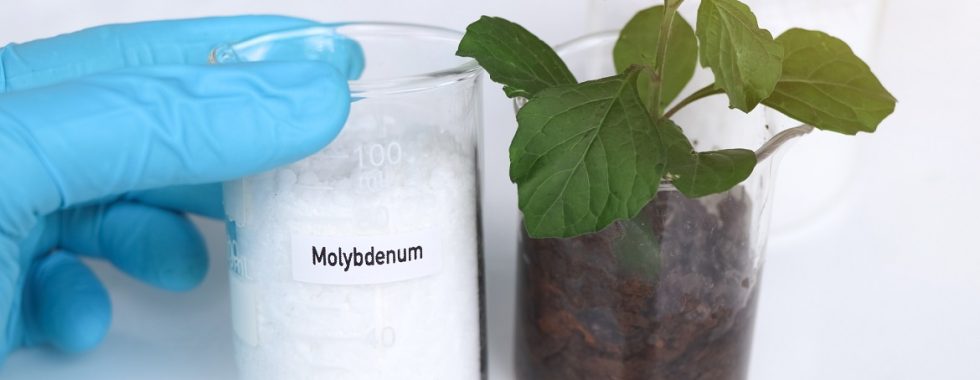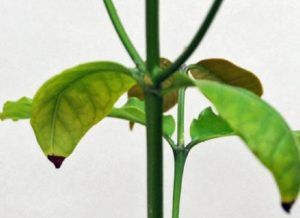Molybdenum Matters: How to Enhance Crop Performance
Molybdenum is an essential micronutrient, which plays essential roles in plant development and productivity. However, it often receives less attention compared to other nutrients.
It naturally occurs in soil, water, and various biological organisms. While plants require only small amounts of molybdenum, its presence is crucial for several enzymatic processes, particularly those involved in nitrogen metabolism. Plants take up molybdenum primarily in the form of molybdate anion (MoO42-).
The importance of molybdenum as an essential plant nutrient was first highlighted in 1942 by A.J. Anderson in Australia. Anderson reported significant responses in sub clover, indicating the pivotal role of molybdenum in plant growth and productivity.
Roles of Molybdenum in Plants
Molybdenum has multifaceted functions in plant biology, encompassing the critical conversion of atmospheric nitrogen, the activation of essential enzymatic pathways, and the support of reproductive processes.
- Nitrogen fixation: Molybdenum is a key component of nitrogenase enzymes, which are essential for converting atmospheric nitrogen into a form usable by plants. This process is particularly crucial in leguminous crops such as soybeans, peas, and alfalfa, which heavily rely on molybdenum for efficient nitrogen fixation. The bacteria in the root nodules of these plants require molybdenum to activate the nitrogenase enzymes, facilitating the symbiotic relationship that allows for the conversion of atmospheric nitrogen into ammonia, a form of nitrogen that plants can readily assimilate.
- Enzymatic activity: Molybdenum-dependent enzymes participate in various biochemical pathways critical for plant growth and development. For instance, the enzyme nitrate reductase facilitates the conversion of nitrate into nitrite, a precursor for amino acids and proteins. Another molybdenum-dependent enzyme, sulfite oxidase, is involved in sulfur metabolism.
- Seed formation and germination: Molybdenum plays a vital role in the synthesis of phytohormones, such as abscisic acid (ABA), which regulates seed dormancy, germination, and early seedling growth. Therefore, adequate molybdenum levels are necessary for optimal seed formation and viability.
Molybdenum’s Availability in Soil
Plant-available molybdenum represents, on average, 2-20% of total molybdenum in soil. It binds to clay and organic colloids in the soil, making it resistant to leaching.
Molybdenum’s availability varies with soil pH. Its availability increases in alkaline soils, at a pH >7.5. However, in acidic soils, molybdenum binds strongly to iron and aluminum hydrates, phosphates, and clays, leading to decreased availability.
Conversely, the availability of molybdenum in acidic soils decreases as the adsorption of anions to soil oxides significantly increases. In acidic soils, the concentration of hydrogen ions (H⁺) in the soil solution increases. This abundance of H⁺ ions results in a higher concentration of positively charged sites on soil colloids. Given that molybdenum primarily exists in the form of a negatively charged ion (MoO₄²⁻) in the soil solution, it tends to bind to these positively charged sites on soil colloids.
Maintaining proper soil pH through liming can optimize molybdenum uptake by plants.
Interactions of Molybdenum with Soil Components
Molybdenum’s behavior in soil is influenced by its interactions with various soil components, including sulfur, phosphorus, copper, aluminum and iron oxides, and organic matter. Therefore, understanding these interactions is crucial for managing molybdenum availability and optimizing plant nutrition.
Interactions with sulfur
Sulfur can interfere with the absorption and translocation of molybdenum within the plant. Therefore, high sulfur concentrations might lead to reduced molybdenum uptake and potential deficiency symptoms. This antagonistic effect of sulfur on molybdenum uptake, can result in impaired nitrogen fixation in leguminous crops and other metabolic imbalances in plants.
Furthermore, sulfur has an acidifying effect on the soil. It might lower the soil pH, creating conditions that may reduce the availability of molybdenum.
Interactions with phosphorus
The presence of soluble phosphorus in soil has been shown to enhance the uptake of molybdenum by plants. For example, research suggests that phosphorus has a stimulating effect on molybdenum uptake mechanisms within plant roots. Phosphate ions (PO43-) are thought to play a key role in promoting the uptake of molybdenum by plants. Additionally, phosphate ions may facilitate the formation of a complex known as phosphomolybdate anion, which is absorbed more readily by plant roots.
Interactions with copper
Like sulfur, high concentrations of copper can interfere with the absorption and translocation of molybdenum within the plant, which may lead to reduced molybdenum uptake and potential deficiency. This interference occurs due to various factors, including the chemical similarity between molybdenum and copper, which can lead to competitive inhibition for uptake mechanisms within the plant.
Interactions with aluminum and iron oxides
Molybdenum interacts with aluminum and iron oxides, which are common soil minerals with a high surface area and reactive sites. Therefore, in acidic soils, where aluminum and iron oxides are prevalent, molybdenum tends to strongly bind to these minerals. Furthermore, soil pH influences the extent of molybdenum adsorption to aluminum and iron oxides, with higher sorption occurring in acidic conditions.
Interactions with organic matter
Organic matter plays a vital role in soil fertility and nutrient cycling, including molybdenum dynamics. Molybdenum binds to organic matter through surface complexation and electrostatic interactions, contributing to its retention and release in soil. Due to these interactions, organic matter can serve as a reservoir of molybdenum, gradually releasing it for plant uptake over time.
Additionally, organic matter enhances soil structure and microbial activity, which can influence molybdenum availability and cycling in soil ecosystems. Incorporating organic amendments into the soil can improve molybdenum availability and promote sustainable nutrient management practices in agriculture.
[visual-link-preview encoded=”eyJ0eXBlIjoiZXh0ZXJuYWwiLCJwb3N0IjoxMzMzNywicG9zdF9sYWJlbCI6IlBhZ2UgMTMzMzcgLSBGZXJ0aWxpemF0aW9uIGFuZCBJcnJpZ2F0aW9uIOKAkyBUaGVvcnkgYW5kIEJlc3QgUHJhY3RpY2VzIiwidXJsIjoiaHR0cHM6Ly9jcm9wYWlhLmNvbS9mZXJ0aWxpemF0aW9uLWFuZC1pcnJpZ2F0aW9uLWJvb2s/a2V5MT1hIiwiaW1hZ2VfaWQiOi0xLCJpbWFnZV91cmwiOiJodHRwczovL2Nyb3BhaWEuY29tL3dwLWNvbnRlbnQvdXBsb2Fkcy9FYm9vay1tb2NrdXAyMDIzLmpwZyIsInRpdGxlIjoiRmVydGlsaXphdGlvbiBhbmQgSXJyaWdhdGlvbiBCb29rIC0gRXhwZXJ0IEd1aWRlIHwgQ3JvcGFpYSIsInN1bW1hcnkiOiJPcHRpbWl6ZSBjcm9wIG1hbmFnZW1lbnQgd2l0aCB0aGUgZmVydGlsaXphdGlvbiBhbmQgaXJyaWdhdGlvbiBib29rLiBMZWFybiBhYm91dCBzb2lsIGFuYWx5c2lzLCBpcnJpZ2F0aW9uIHNjaGVkdWxpbmcsIHBsYW50IG51dHJpZW50cywgZmVydGlnYXRpb24gYW5kIG1vcmUuIiwidGVtcGxhdGUiOiJ1c2VfZGVmYXVsdF9mcm9tX3NldHRpbmdzIn0=”]
Symptoms of Molybdenum Deficiency
Molybdenum deficiency can manifest in various ways, depending on plant species and environmental conditions. For example, common symptoms include stunted growth, yellowing of older leaves, reduced nitrogen fixation, abnormal leaf development, and delayed flowering and fruiting.
The sensitivity of crops to molybdenum deficiency varies significantly across different types of crops. The table below categorizes various crops based on their level of sensitivity to molybdenum deficiency.
| Sensitivity Level | Crops |
| Very Sensitive | Legumes (peas, beans, lentils), Crucifers (cauliflower, broccoli, kale, cabbage), Leafy Vegetables (spinach, lettuce), Citrus Trees |
| Moderately Sensitive | Grains (wheat, corn), Root Crops (carrots, beets), Fruit Crops (apples, grapes), Tomatoes, Peppers |
| Tolerant | Cereals (rice, barley, oats), Grasses (pasture and forage grasses), Tubers (potato), Some Root Vegetables |
Examples of deficiency symptoms in different crops:
Legumes (e.g., Soybeans)
Yellowing of leaf margins: The older leaves often show a characteristic yellowing at the margins, progressing towards the center.
Stunted growth: Plants may exhibit reduced growth rates, resulting in smaller plants with fewer and smaller leaves.
Poor nitrogen fixation: There might be a noticeable reduction in nitrogen fixation efficiency, evidenced by fewer or smaller nodules on roots, leading to nitrogen deficiency symptoms even in nitrogen-rich soils.
Crucifers (e.g., Cauliflower)
Whiptail: A distinctive condition where the leaf blades become distorted and narrow, leading to a “whip-like” appearance. This is most noticeable in the new leaves.
Pale or yellow leaves: Leaves may appear paler than normal, with younger leaves sometimes showing a more pronounced yellowing.
Citrus
Yellow spotting: Leaves may develop yellow spots between veins, which is a common symptom of molybdenum deficiency in citrus.
Mottled leaves: A mottling of the leaves can occur, along with a general thinning of the leaf canopy due to decreased photosynthesis efficiency.
Images of molybdenum deficiencies:
Molybdenum deficiency in coffee and cauliflower (source: Yara)
Molybdenum Sources and Management
- Soil amendments: Soil testing is crucial for assessing molybdenum levels and determining appropriate amendments. Application of molybdenum-containing fertilizers or organic amendments such as compost can help alleviate deficiencies.
- Foliar sprays: Foliar application of molybdenum can provide a quick and efficient solution, especially during critical growth stages or when deficiency symptoms appear.
- Crop rotation and legume intercropping: Incorporating leguminous crops into rotation systems can enhance soil fertility and molybdenum availability through nitrogen fixation.
Molybdenum fertilizers include:
Sodium Molybdate (Na₂MoO₄)
Composition: Sodium molybdate is a highly soluble source of molybdenum, typically containing about 39% molybdenum. It’s widely used in both foliar sprays and soil applications due to its high solubility and ease of absorption by plants.
Ammonium Molybdate ((NH₄)₆Mo₇O₂₄·4H₂O)
Composition: Ammonium molybdate contains around 54% molybdenum. It is another soluble form of molybdenum, suitable for foliar applications and fertigation systems. This compound provides molybdenum in a form that is readily available to plants.
Molybdenum Trioxide (MoO₃)
Composition: Molybdenum trioxide contains about 66% molybdenum. It is less soluble than sodium and ammonium molybdate, making it more suitable for soil applications where a slower release of molybdenum is desired.
Molybdenum Chelates
Composition: Molybdenum chelates are complexes of molybdenum with organic molecules, which enhance its solubility and plant availability. The exact composition and molybdenum content can vary depending on the chelating agent used.
[visual-link-preview encoded=”eyJ0eXBlIjoiZXh0ZXJuYWwiLCJwb3N0IjoxMzMzNywicG9zdF9sYWJlbCI6IlBhZ2UgMTMzMzcgLSBGZXJ0aWxpemF0aW9uIGFuZCBJcnJpZ2F0aW9uIOKAkyBUaGVvcnkgYW5kIEJlc3QgUHJhY3RpY2VzIiwidXJsIjoiaHR0cHM6Ly9jcm9wYWlhLmNvbS9mZXJ0aWxpemF0aW9uLWFuZC1pcnJpZ2F0aW9uLWJvb2s/a2V5MT1hIiwiaW1hZ2VfaWQiOi0xLCJpbWFnZV91cmwiOiJodHRwczovL2Nyb3BhaWEuY29tL3dwLWNvbnRlbnQvdXBsb2Fkcy9FYm9vay1tb2NrdXAyMDIzLmpwZyIsInRpdGxlIjoiRmVydGlsaXphdGlvbiBhbmQgSXJyaWdhdGlvbiBCb29rIC0gRXhwZXJ0IEd1aWRlIHwgQ3JvcGFpYSIsInN1bW1hcnkiOiJPcHRpbWl6ZSBjcm9wIG1hbmFnZW1lbnQgd2l0aCB0aGUgZmVydGlsaXphdGlvbiBhbmQgaXJyaWdhdGlvbiBib29rLiBMZWFybiBhYm91dCBzb2lsIGFuYWx5c2lzLCBpcnJpZ2F0aW9uIHNjaGVkdWxpbmcsIHBsYW50IG51dHJpZW50cywgZmVydGlnYXRpb24gYW5kIG1vcmUuIiwidGVtcGxhdGUiOiJ1c2VfZGVmYXVsdF9mcm9tX3NldHRpbmdzIn0=”]



